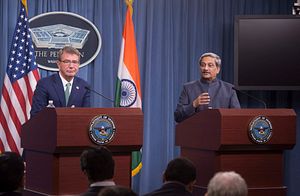Finally, after years of dilly-dallying, India and the United States have managed to sign the bilateral Logistics Exchange Memorandum of Agreement (LEMOA). The agreement will facilitate the provision of logistical support, supplies, and services between the U.S. and Indian militaries on a reimbursable basis, providing a framework to govern them.
The two countries had agreed “in principle” on such an agreement during U.S. Defense Secretary Ash Carter’s visit to Delhi in April this year. Indian Defense Minister Manohar Parrikar’s visit to the U.S. last month resulted in the final pact. LEMOA is expected to help the two militaries coordinate better, including in exercises, and also allow the United States to more easily sell fuel or provide spare parts to the Indians. The pact will emphasize strengthening defense ties across many areas, from strategic and regional cooperation, to deepened military-to-military exchanges, to expanded collaboration on defense technology and innovation. With its signing, U.S.-India defense ties have taken a major step towards further consolidation.
The geopolitical grounding for this consolidation is provided by the rise of China and all that means for Indian strategic interests. China has shown no signs that it is willing to change or even moderate its anti-India posture and has in fact taken an overtly antagonistic posture vis-à-vis India. To counter the China challenge, the United States wants a “network” of countries with “shared values, habits of cooperation, and compatible and complementary capabilities,” which will expand the strategic reach of the participating countries, enable them to pool their resources to share the security burden, and, thereby, “help ensure the peace and stability in the region for years to come.”
New Delhi need not become part of this network, but it needs to articulate the need for a new security architecture in Asia that can successfully take on the challenge posed by a rising and aggressive China. During Parrikar’s visit, he and his American counterpart mentioned the importance of the free flow of trade to both countries, underscoring their “shared interest in freedom of navigation and overflight and unimpeded commerce as part of rule-based order in (the) Indo-Pacific.” Delhi and Washington are now focusing on maritime security with another round of maritime dialogue to follow the inaugural one held earlier this year in May.
India and the United States have further been striving to conclude a series of “foundational agreements” for years now and under the previous United Progressive Alliance government in Delhi, even the least controversial—the logistics—could not move forward as then-Defense Minister A.K. Antony under the influence of the Left parties became convinced about America’s malign motives in pushing it through.
With the LEMOA now finalized, the two nations can finally move forward with some confidence about the future of their defense ties. India is in the big leagues today and should start thinking big. The old Third World rhetoric doesn’t do justice to Indian global aspirations. The defense pact between the U.S. and India will help both countries in governing the use of each other’s land, air, and naval bases for repair and resupply, a step toward building up additionally defense ties as they seek to counter the growing maritime assertiveness of China.
The conclusion of LEMOA along with Indian Prime Minister Narendra Modi’s decision to skip the Non-Aligned Movement (NAM) summit this week in Venezuela underscore New Delhi’s rapidly changing foreign policy priorities. The Modi government is gradually shedding Indian strategic diffidence and seems to have rightly concluded that strong defense ties with the United States enhance Indian strategic autonomy rather than constraining it.

































